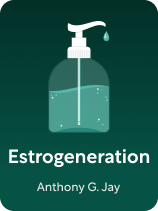

This article is an excerpt from the Shortform book guide to "Estrogeneration" by Anthony G. Jay. Shortform has the world's best summaries and analyses of books you should be reading.
Like this article? Sign up for a free trial here.
How do endocrine disruptors cause a decline in testosterone? How does testosterone travel through the body?
Testosterone plays a big part in your physical and mental health. But, in the presence of estrogenics—one of the known endocrine disruptors—testosterone decreases rapidly, which can lead to major problems.
Continue reading for more information on the effect of estrogenics on testosterone.
How Endocrine Disruptors Cause Hormone Imbalance
Anthony G. Jay discusses a health issue associated with endocrine disruptors: testosterone’s declining rates among men and women across the world. While testosterone levels have been declining naturally over thousands of years, there’s been a steep drop in recent history.
(Shortform note: Research shows that the average men’s testosterone levels are dropping about 1% every year. Many experts acknowledge endocrine-disrupting chemicals like estrogenics as contributing to declining testosterone rates, but they note that other factors also contribute to this trend—including weight gain, lack of physical activity, poor diet, excessive alcohol consumption, and disrupted sleep.)
Testosterone plays a critical role in the development and maintenance of your physical and mental health, influencing your sex drive, muscle mass and strength, bone density, mood, energy levels, and general well-being. Testosterone and estrogen (along with estrogenic compounds) also affect the brain’s neuroplasticity—its ability to reorganize itself by forming new neural connections.
Jay writes that estrogenics reduce the amount of usable testosterone in your body. To understand how, let’s first discuss how testosterone travels within your body and what usable testosterone is: Testosterone and estrogen are hydrophobic, so they need the help of a non-hydrophobic protein to travel through your bloodstream (which is mostly water). As a result, the majority of testosterone in your body binds to this protein—known as sex hormone-binding globulin (SHBG)—and isn’t readily usable by the body. However, a small percentage of testosterone remains unbound in your bloodstream as free testosterone, which is the most usable form for your body.
Jay explains that estrogenics lower your free testosterone levels in three ways: They increase the amount of SHBG in your blood, reduce the number of testosterone receptors in your body, and block testosterone from binding to receptors. This leads to two major problems:
1. Precocious puberty. The onset of puberty is occurring earlier than ever before (especially for girls), which can lead to psychological and physical health problems.
(Shortform note: The average age for a girl’s first period has moved from about 16 a century ago to approximately 13 today. Other experts explain that early puberty influences children’s self-perception and social relationships, resulting in a higher risk for mental health problems, substance use, and early sexual behavior, particularly for girls.)
2. The “feminization of males.” Hormonal disruptions reduce motivation specifically in men. Jay writes that this may explain the reason that participation in boy’s sports is falling nationwide and that more women are enrolling in universities than men.
(Shortform note: While other experts also note these trends, they propose alternative reasons. When it comes to youth sports, some argue that cost is the biggest factor: Sports participation is only declining among children from lower- and middle-income families while participation from children from wealthier families is rising. Others argue that fewer men enroll in colleges because of changes to the economy and sociocultural norms, which have disrupted traditional pathways for men—for example, economic changes have made it harder to secure middle-class wages with only a high school diploma, impacting men who had relied on manual labor jobs.)
| How to Rebalance Your Hormones Other experts agree on the importance of keeping your hormones balanced. Having a healthy level of testosterone builds lean muscle mass, strengthens your bones, and improves your heart health, libido, mood, and thinking skills such as verbal and spatial memory and mathematical reasoning. To assess your testosterone levels, you can take several different tests: Total testosterone test: measures both free and SHBG-bound testosterone. Free testosterone test: measures only “active” testosterone unbound to SHBG. Bioavailable testosterone test: measures free testosterone and testosterone bound to another protein called albumin. SHBG blood test: measures the amount of SHBG in your blood. Natural methods to increase testosterone levels include exercise (weightlifting and high-intensity interval training, in particular), consuming a balanced, nutritious diet, reducing stress, taking more vitamin D, improving sleep quality, reducing alcohol intake, and taking supplements. Testosterone therapy is also an option for people with low testosterone levels. |

———End of Preview———
Like what you just read? Read the rest of the world's best book summary and analysis of Anthony G. Jay's "Estrogeneration" at Shortform.
Here's what you'll find in our full Estrogeneration summary:
- How estrogenics are causing a rise in health problems
- How to avoid estrogenics and detoxify your body
- Why you shouldn't eat foods packed in plastic packaging or cans






